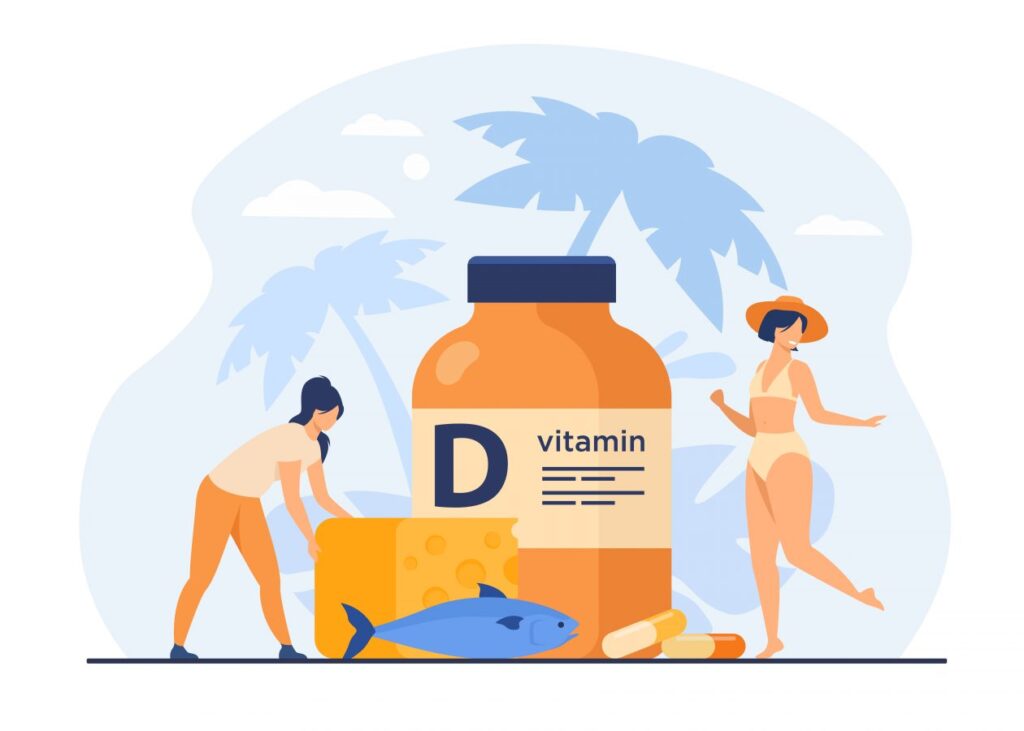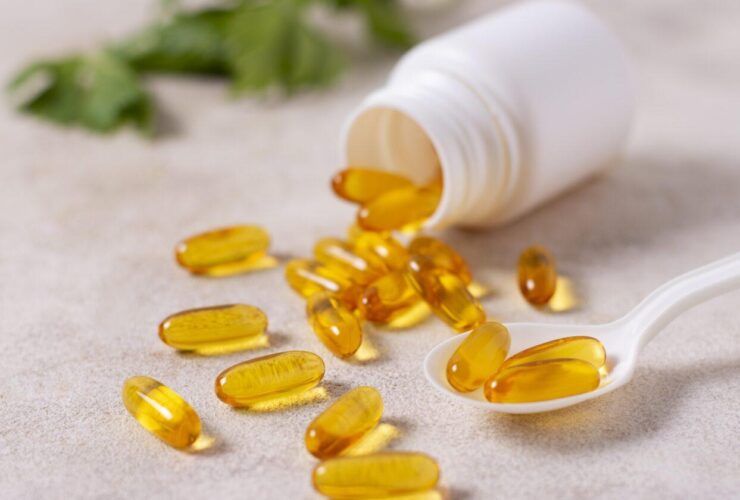Introduction
Vitamin D is a fat-soluble vitamin essential to several bodily physiological functions. In contrast to other vitamins mainly acquired from diet, the skin also produces vitamin D when exposed to sunshine. Because of this exceptional quality, it is vital to general health and well-being.
Due to its ability to facilitate the absorption of calcium and phosphorus, vitamin D is well known for its function in supporting bone health. Its importance, however, goes beyond bone health to encompass immune system performance, mood control, and even weight control. Sufficient amounts of vitamin D have been linked to a lower chance of developing chronic illnesses like diabetes, heart disease, and cancer.
Sunlight, especially the UVB rays that start the production of vitamin D in the skin, is one of the primary sources of this nutrient. But clouds can block away a large portion of UVB light that reaches the Earth’s surface, so it could be more apparent if vitamin D can still be obtained on gloomy days. This section will address potential inadequacies by examining the variables affecting vitamin D production, discussing how cloud cover affects UVB penetration, and offering suggestions for substitute vitamin D sources.
Factors Influencing Vitamin D Production
Previtamin D3 is created when UV rays from the sun react with 7-dehydrocholesterol, a kind of cholesterol found in the skin. After undergoing several chemical processes, the body eventually produces active vitamin D from this vitamin D3. This procedure demonstrates that UV radiation is essential for starting the skin’s vitamin D synthesis.
Sunlight exposure, which is highest in UVB radiation at specific times of the day, initiates vitamin D production in the skin. Sunlight that is full-spectrum contains the UVB photons that the skin needs to make vitamin D. A reaction with a cholesterol component in the skin happens when the skin is exposed to these UVB rays, which results in vitamin D creation.
Cloud cover can significantly decrease the quantity of UVB radiation that reaches the planet’s surface. Even though some UV rays can get through clouds, on overcast days overall, UV radiation is not as intense as on clear, sunny days. Consequently, during cloudy conditions, the skin’s capacity for producing vitamin D may be reduced.
People might need to spend more time outside on overcast days to get the recommended amount of UV exposure for the synthesis of vitamin D. Even on cloudy days, prolonged outdoor exertion can nevertheless aid in the creation of vitamin D, albeit more slowly than on sunny ones. It’s crucial to balance sun exposure with skin protection measures to reduce the danger of sunburn and skin damage.
Seasonal differences in sunshine exposure can influence vitamin D generation; summertime exposure is generally associated with greater UV levels than wintertime exposure. When the sun is higher in the sky and the days are longer in the summer, vitamin D synthesis may be more effective in areas with distinct seasons. On the other hand, the body’s vitamin D levels may drop throughout the winter when there is less exposure to the sun.
A form of depression known as seasonal affective disorder (SAD) typically manifests cyclically in the fall and winter when daylight hours are reduced. Because the body’s vitamin D levels can drop during these seasons due to less exposure to sunlight, some research indicates a connection between SAD and vitamin D deficiency. For some people, taking vitamin D supplements or spending more time in the sun throughout the day may help reduce the symptoms of seasonal affective disorder.
Geographical and Skin Color Influence
Living in northern locations at higher latitudes makes it challenging to produce enough vitamin D, especially in the winter when there is less solar exposure. At higher latitudes, the angle at which sunlight strikes the Earth’s surface diminishes the strength of UV radiation, impeding the skin’s capacity to produce vitamin D. Because of this, people who live in these regions may be more susceptible to vitamin D shortage and should think about getting their vitamin D from other sources, including supplements or foods that have been fortified.
Dietary vitamin D sources become more crucial in areas with little sunshine exposure. Foods high in vitamin D, like fortified dairy products, fortified cereals, and fatty fish (trout, salmon, and mackerel), can help top up the body’s vitamin D stores, mainly when sun exposure is limited. Consuming these meals can be especially advantageous for people living in higher latitudes where long periods without sunlight are spent outside.
The hue of a person’s skin significantly impacts their ability to withstand UV radiation and produce vitamin D. The pigment that gives skin its color, melanin, functions as a natural sunscreen by absorbing UV rays and shielding the layers of skin beneath from harm. Higher melanin levels offer more excellent UV protection, but this protective effect may also be counteracted by a decreased skin’s capacity to synthesize vitamin D in reaction to sunshine. As a result, compared to people with lighter skin tones, those with darker skin tones might need to spend longer in the sun to synthesize enough vitamin D.
Sunlight is the primary source of vitamin D, but to reduce the danger of sunburn and skin cancer, it’s crucial to balance sun exposure with skin protection measures. Spending time outside during off-peak UV hours, using protective gear like long sleeves and wide-brimmed hats, and applying sunscreen with a high enough sun protection factor (SPF) are all advised for safe sun exposure. People can minimize the hazards of excessive sun exposure and optimize vitamin D production by adopting sun safety precautions.
Safe Sun Exposure Practices
Cloudy days might offer people a false sense of security regarding sun exposure, but cloud cover or not, sun safety should always come first. Even when the sun isn’t visible, UV radiation can still pass through clouds, increasing the risk of sunburn and skin damage. To lower their risk of sunburn and long-term skin damage, people should take sun safety precautions such as using sunscreen with a high SPF, finding shade during peak UV hours, and dressing in protective clothing. Furthermore, wearing sunglasses that block entirely UV rays helps shield the eyes from damaging UV rays. It lowers the risk of eye damage and vision issues from extended sun exposure.
Melanin levels in the skin can be gradually increased by gradual exposure to sunshine during reduced UV intensity, eventually increasing UV resistance. People can increase their natural defense against UV radiation by progressively increasing their time in the sun. This is done by encouraging the development of melanin in the skin.
This method helps improve the skin’s capacity to manufacture vitamin D effectively while lowering the danger of sunburn. Seasonal Affective Disorder (SAD) is a type of depression that occurs at various periods of the year, frequently in reaction to decreasing sunshine exposure during the winter months. Building melanin through safe sun exposure methods can also positively affect SAD. Improving UV tolerance through responsible sun exposure can help reduce SAD symptoms and enhance general well-being.
Health Implications of Vitamin D
Beyond only maintaining strong bones, vitamin D is essential for many other areas of our health. Its immune system support is one important feature. According to research, vitamin D may lower the risk of infections and autoimmune disorders by regulating immune function. Furthermore, sufficient amounts of vitamin D have been connected to better regulation of mood, while insufficiencies are frequently linked to disorders like seasonal affective disorder (SAD) and depression.
Furthermore, new research suggests a possible connection between weight control and vitamin D levels, with some data indicating that consuming enough vitamin D may support weight loss initiatives. These numerous advantages emphasize the importance of keeping vitamin D levels at their ideal levels for general health and well-being.
Beyond just its effects on immunity, vitamin D plays a significant role in managing weight. Research has indicated a possible connection between obesity and vitamin D deficiency. Therefore, vitamin D supplements, a balanced diet, and regular exercise may help support weight loss attempts.
Moreover, the presence of vitamin D receptors in brain regions linked to mood regulation suggests a possible role for vitamin D in mental health. Sufficient levels of vitamin D have been linked to a decreased likelihood of depression and seasonal affective disorder (SAD), a form of depression that usually manifests in the winter when there is less exposure to sunlight. For this reason, maintaining adequate vitamin D consumption through diet, supplements, or appropriate sun exposure techniques is essential to maintaining good mental and physical health.
Other Sources of Vitamin D

Although exposure to sunshine is still the best way to get vitamin D, gloomy days might make it less accessible. Nevertheless, you can get these vital minerals from other foods by including them in your diet. Salmon, mackerel, and tuna are examples of fatty fish that are great providers of vitamin D. On overcast days, eating this fish can help you get more vitamin D. Incorporating additional vitamin D-rich foods, such as eggs, fortified dairy products, and fortified cereals, might also help you reach your daily needs, mainly if you don’t get much sunlight.
Vitamin D supplements can be a practical and efficient means of guaranteeing appropriate intake when exposure to natural sunlight or dietary sources is inadequate. But when adding supplements to your regimen, it’s essential to consider a few things. Determining the correct dosage depending on personal needs and pre-existing medical issues might be aided by speaking with a healthcare provider. Furthermore, it’s critical to choose premium supplements that contain vitamin D3 or the active form of vitamin D. Supplements should only partially replace sun exposure, even though they can support dietary sources of vitamin D and help maintain ideal levels. Achieving equilibrium between outdoor exposure and supplements is essential for maintaining general health and well-being.
Can You Get Vitamin D on a Cloudy Day?
In Short, Yes, it’s possible to get vitamin D on a cloudy day, albeit in reduced amounts compared to sunny days. Cloud cover can filter and diminish UVB radiation, which is essential for skin vitamin D synthesis. However, some UVB rays still penetrate through clouds, allowing for some vitamin D production, albeit at a lower intensity.
Dispelling Common Misconceptions:
- UV penetration through clouds: Contrary to popular belief, clouds do not entirely block UV radiation. While thick cloud cover significantly reduces UVB rays reaching the Earth’s surface, thin clouds may still allow some UVB penetration, albeit at diminished levels.
- The role of thin vs. thick cloud cover: Thin clouds may filter UVB radiation to a lesser extent, allowing for some vitamin D synthesis. In contrast, thick cloud cover is a more effective barrier, reducing UVB penetration and limiting vitamin D production.
Best Practices for Cloudy Days
- Optimal times for sun exposure: Aim for outdoor activities during midday when UVB radiation is typically at its peak to maximize vitamin D synthesis on cloudy days. Even though cloud cover reduces UVB intensity, exposure during midday hours increases the likelihood of sufficient UVB reaching the skin.
- Caution against sunburn even on cloudy days: While cloud cover may obscure the sun, it’s essential to practice sun safety measures to prevent sunburn and skin damage. Apply sunscreen with a broad-spectrum SPF, wear protective clothing, and seek shade during prolonged outdoor activities to reduce the risk of sunburn and overexposure to UV radiation.
Unique Insights and Practical Tips

A. Overcoming Obstacles to Vitamin D
- Addressing challenges in modern lifestyles: In today’s fast-paced world, many individuals face obstacles in obtaining adequate vitamin D, especially on cloudy days when sunlight exposure is reduced. To overcome this challenge, consider integrating vitamin D-rich foods into your diet, such as fatty fish, fortified dairy products, and egg yolks. Additionally, explore outdoor activities that can be enjoyed even on cloudy days, such as walking, hiking, or gardening, to maximize sun exposure when possible.
- Incorporating vitamin D-rich habits in daily life: Cultivating habits that promote vitamin D intake is crucial for maintaining optimal health, regardless of weather conditions. Take advantage of sunny days to spend time outdoors and engage in activities that allow for sun exposure. Additionally, consider incorporating vitamin D supplements into your daily routine, especially during periods of limited sun exposure. You can establish sustainable habits that support vitamin D levels year-round by prioritizing dietary sources and outdoor activities.
B. Vitamin D and Wellness
- Comprehensive benefits beyond bone health: While vitamin D is commonly associated with bone health, its benefits extend beyond calcium absorption. Adequate vitamin D levels have been linked to immune system support, mood regulation, and reduced risk of chronic diseases, including cardiovascular conditions and certain cancers. Therefore, sufficient vitamin D intake is essential for overall wellness and disease prevention.
- Addressing deficiencies through a holistic approach: Recognizing the importance of vitamin D in promoting overall health, it’s essential to adopt a holistic approach to address shortcomings. In addition to sunlight exposure and dietary sources, factors such as genetics, skin type, and geographic location can influence vitamin D levels. Consult with a healthcare professional to assess your vitamin D needs and develop a personalized plan encompassing dietary modifications, supplementation, and lifestyle adjustments to optimize your vitamin D status and support overall wellness.
FAQ about Vitamin D and Sun Exposure
Q: Can you get vitamin D while in the shade?
A: Shade is essential as a UV minimization strategy; however, it may also play a crucial role in providing the human body with adequate levels of UVB radiation for pre-Vitamin D3 production without experiencing the relatively higher levels of UVA irradiances present in full sun. While direct sunlight is the primary source of vitamin D synthesis in the skin, limited UVB radiation can still penetrate shaded areas, allowing for some vitamin D production even in the shade.
Q: Can you get vitamin D if there is no sun?
A: Vitamin D synthesis in the skin is primarily triggered by exposure to UVB radiation from the sun. Therefore, in the absence of sunlight, such as during nighttime or in heavily overcast conditions, the body’s ability to produce vitamin D is significantly reduced. However, dietary sources and supplements remain alternative options for obtaining vitamin D when sun exposure is limited.
Q: How long must you be in the sun to get vitamin D?
A: Sun exposure required to produce sufficient vitamin D varies depending on skin type, time of day, geographic location, and atmospheric conditions. Generally, spending around 15 to 30 minutes in the sun during peak UVB hours without sunscreen can help stimulate vitamin D synthesis in the skin. However, individual needs may vary, and it’s essential to balance sun exposure to avoid the risk of sunburn and skin damage.
Q: How do you get vitamin D on a rainy day?
A: On rainy days, when sunlight is scarce, obtaining vitamin D from natural sources becomes challenging. However, you can still support your vitamin D levels through dietary sources such as fatty fish, fortified dairy products, egg yolks, and vitamin D supplements. Additionally, engaging in indoor activities near windows or utilizing artificial UVB lamps may offer some alternative sources of UV radiation for vitamin D synthesis. However, caution should be exercised to avoid excessive exposure.
Conclusion
Even though they may appear to hinder vitamin D absorption, cloudy days present opportunities for sufficient exposure; although direct sunshine is the primary source of vitamin D synthesis, UVB rays can still pass through clouds, albeit at a lower intensity. Consequently, getting outside—even on overcast days—can aid in synthesizing vitamin D. But to reduce the chance of sunburn and skin damage, it’s crucial to balance your sun exposure. The possibilities of synthesizing vitamin D can be increased while limiting the time required for sun exposure during optimal times, such as midday when the sun is at its highest in the sky.
Even with the difficulties of overcast weather, people can maintain their vitamin D levels through food and supplementation. Even when sunlight is rare, foods high in vitamin D, such as egg yolks, dairy products with added vitamin D, and fatty fish, can supply vital minerals. Furthermore, vitamin D tablets provide a dependable and practical means of ensuring sufficient levels, particularly for individuals with restricted sun exposure. People can guarantee adequate amounts of vitamin D for their general health and well-being through a well-rounded strategy incorporating outdoor exposure, food decisions, and supplementation.
Reference:
Norman, Anthony W, and Helen L Henry. 2015. “Calcium-Regulating Hormones.” Elsevier EBooks, January, 189–221. https://doi.org/10.1016/b978-0-08-091906-5.00009-4.
gazetteterrymurphy. 2023. “Vitamin D Benefits Linked to Body Weight.” Harvard Gazette. Harvard Gazette. January 17, 2023. https://news.harvard.edu/gazette/story/2023/01/weight-plays-role-in-vitamin-ds-health-benefits/.
https://www.facebook.com/WebMD. 2020. “Foods High in Vitamin D.” WebMD. June 19, 2020. https://www.webmd.com/vitamins-and-supplements/ss/slideshow-foods-high-in-vitamin-d.
Németh, P., Tóth, Z., & Nagy, Z. (1996). Effect of weather conditions on UV-B radiation reaching the Earth’s surface. Journal of Photochemistry and Photobiology B: Biology, 32(3), 177-181. https://doi.org/10.1016/1011-1344(95)07221-7
“What Is the Difference between UVA and UVB Rays?” 2018. University of Iowa Hospitals & Clinics. April 2018. https://uihc.org/health-topics/what-difference-between-uva-and-uvb-rays.
(1) Vitamin D | The Nutrition Source
https://www.hsph.harvard.edu/nutritionsource/vitamin-d/
(2) Overview of Vitamin D -Dietary Reference Intakes for Calcium and Vitamin D.
https://www.ncbi.nlm.nih.gov/books/NBK56061
(3) Vitamin D2 vs. D3: What’s the Difference? – Healthline
https://www.healthline.com/nutrition/vitamin-d2-vs-d3
(4) Vitamin D Metabolism and Guidelines for Vitamin D Supplementation
https://www.ncbi.nlm.nih.gov/pmc/articles/PMC7731935/
Was this helpful?

Joseph Emb, RDN
Founder of StyleVitally.com | Registered Dietitian & Wellness Advocate
What I Cover:
I’m passionate about connecting nutrition science and everyday wellness to help people live healthier, more vibrant lives. I write about evidence-based nutrition, mindful eating, sustainable lifestyles, and holistic well-being at StyleVitally.com.
My Background:
The University of Texas in Austin, where I earned my Dietetics diploma, laid the groundwork for my nutrition and health career. My training and hands-on experience taught me the science and art of using nutrition to enhance health and well-being.
Professional Journey:
I’m an RDN with lots of experience. I’ve helped people seeking tailored nutritional recommendations in clinical settings and community outreach programs. My constant learning and professional development ensure that my recommendations are always based on the latest evidence.
Ethical Commitment:
My practice prioritizes integrity. My content is transparent and objective, following the most significant ethical standards. I can give my audience unbiased advice because I’m not affiliated with food businesses or industry associations. I want to help people make informed health decisions that match their values and ambitions.
Join Me on the Wellness Journey:
Join me on the path to vitality and well-being, whether facing nutritional issues, seeking sustainable lifestyle changes, or simply wanting a better, happier you. We’ll discover how diet, mindfulness, and holistic well-being can maximize your potential.










Leave a Reply
View Comments